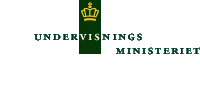
Chapter 5
Best Practices on Sustainability from schools in the Baltic Sea Region
Agriculture
By Niels Madsen, Denmark
Teaching sustainable agriculture to
students
Esrum Møllegård’s Centre for Nature & Environment is located in northern Zealand, 50 km north of Copenhagen. For the last 10 years we have acted as a nature and environmental school. Part of our work is environmental education of visiting school classes. Most of our activities are single-day activities, where we use the surrounding nature for investigations. Concerning our programme on agriculture, we consider it our main task to open students‘ eyes to modern agricultural methods. We take into consideration the effect agriculture might have on the environment, and we discuss the alternatives to modern industrialised farming.
Farming in the 21st century
A few generations back most people were farmers, but in Denmark today less than 2.6% of the working force are farmers. Most people live in urban areas and have no contact with farming.
Visiting a farm is normally not the first wish that comes up in a Danish student’s mind when the class is planning an excursion. Why is that? What thoughts come to students’ minds when we talk about farming? Do they imagine mud and dirty boots, and a smelly, messy place with rusty machinery everywhere, or do they imagine birds singing in the sky, cute animals, fresh air, beautiful landscapes, harmony and no stress?
Of course, students differ in their opinion, but most of our visiting students only have a vague idea of what farming in the 21st century really is. This in itself makes it important to include farming in teaching. The general lack of first-hand knowledge about farming also goes for the daily work on a farm. Students do not know the names of ordinary agricultural machinery, nor do they know what the machinery is used for. Many students are not even familiar with the common crops and domestic animals.
Many students may think that agriculture is not important for them. For me, however, there are four basic facts in opposition to this attitude:
- Agricultural products are very important for Danish export.
- Altogether 65% of the total land area is used for farming. Consequently, farmland completely dominates the Danish landscape.
- Agriculture has a major impact on the environment
. 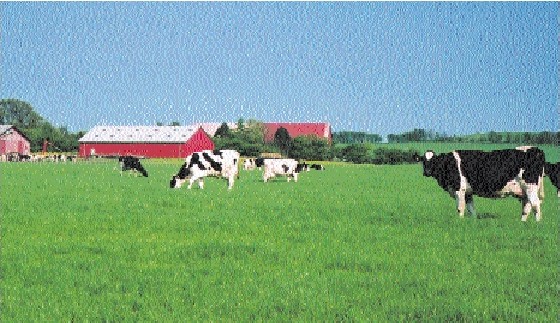
Farmland dominates the Danish landscape
Visiting a farm with a school class
First of all, the farmer takes the students on a guided tour of his farm. The students often ask questions such as: “How can you work in this smell?”, “How much milk can a cow produce per day?”, “Do you give all the animals names?”, and “Do you make a lot of money from farming?” Some questions seem more relevant than others, but they all express an interest in the farm visit, which makes them all relevant.
Agriculture and environment
When we discuss the influence of agriculture on the environment, students often know that fer-tilisers and pesticides may have a negative impact. In Denmark, the increased use of fertilisers has resulted in environmental problems for the aquatic environments and for the groundwater. Also; the manure from livestock leads to environmental problems. The spreading of liquid manure has to take place during plant growth, and the spreading results in an extremely strong odour in the countryside, especially in the spring.
The pesticides used to prevent fungus and insect attacks on plants, or derivates after partial degradation of the herbicide or insecticide, have by now been found in many wells for drinking water. The result is increasingly less clean drinking water for the future.
What students normally do not think about is the influence that farming practice has on the landscape. During the last decades, the typical Danish farm has changed from a small family farm to an increasingly bigger industrial farm, almost like a factory. The traditional farm was characterised by having many small fields with a wide variety of crops. Over the last decades, the farms have grown enormously big with a few large fields with wheat, barley or rape as the only crops. The crops chosen often depend on what crops are subsidised by the EU.
The result has been that many small biotopes have disappeared; biotopes like ponds, living hedges, small groups of trees, stone dikes, etc. This is done to prepare the fields for bigger machinery.
The development removes important corridors, leaves very little space for wild plants and animals, and leads to loss of biodiversity in the agricultural landscapes.
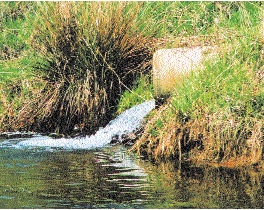
Drainage water from farmland contains nitrogen, phosphorous and pesticides
Animal welfare
This is a topic that can rouse the emotions of young people. Of course, no one approves of cruelty to animals, but most of us buy meat derived from animals raised in stable systems that do not allow normal animal behaviour. Does this not make us guilty of cruelty to animals?
We think it is an important discussion to take up. Our experience is that young people often do not think of the connection between buying meat in shops and animal welfare.
The historical fact is that livestock has changed from many different kinds of animals to a very specialised production of only one type of animal, such as pigs for pork meat, cows for milk production, or poultry for meat or eggs.
Traditionally, the farm had a balance between the size of the livestock and the crops that the fields could produce. Farms were normally more or less self-sufficient.
Today, farms with large-scale animal production import large amounts of fodder, which has often been produced abroad, for example in Ar-gentina or Brazil.
Modern stable systems are factory-like, and often they only provide animals a minimum of possibility for normal behaviour.
The question now is if this is done in order to be cruel to the animals? Of course, farmers are not cruel people, but like every one else, they want a decent income from their work, and todo this, they have seen it as their only possibility to make production increasingly effective.
What lesson can students learn? Our suggestion is that it is up to the consumers to secure animal welfare by buying animal products produced under conditions that respect the natural behaviour of animals.
Sustainable farming
The results of an evaluation of modern farming may show that it is good business for the farmers, but that it may not be a sustainable way to farm in the long term. The environmental problems caused by modern farming may cost a higher price to repair than what is actually earned on the farming. Maybe this price will have to be paid by the next generations!
After the discussion of all these problems, it is natural to look for alternatives to modern conventional farming that have a less severe impact on the environment.
The most successful alternative to conventional (also called traditional or industrialised) farming until now has been organic farming. From the start 20 years ago, the number of organic holdings has risen to 3,500, cultivating a little less than 7% of the total agricultural area in Denmark.
In short, organic farms do not use pesticides or artificial fertilisers.
There are also rules that set the minimum standards for animal welfare.
The important discussion is not to make propaganda for one type of farming practice, but to discuss what difference the practice makes to the environment, to us, to domestic animals, to the landscape, etc.
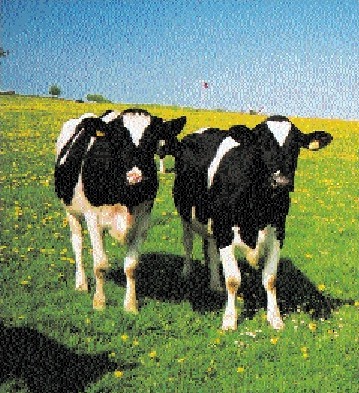
Animal welfare can rouse the emotions of young people
The practical element
– "safari at grass root level"
Our experience is that students best understand the differences between farming practices by making their own examinations. We make examinations on two different farms. Normally, we choose a conventionally-cultivated field, and for comparison, an organically-cultivated field. We discuss if any differences found can be explained by the farming practice.
The lesson learned from many different kinds of environmental education activities is that it is easier to attract attention to animals than to plants. We therefore concentrate on insects, worms and other bugs. Often, it is a big surprise to students how many different animals we can find in the soil.
Earthworms as bioindicators: A high population of earthworms is actually the most important indicator for farmland in biological balance. Worms are important for the decomposition of dead plant materials and manure, and also for good soil structure.
The best way to catch earthworms is to dig up a quarter of a square metre in the field, put the soil on a plastic sheet, and then break the lumps of soil up by hand. The number of worms per m2 may vary from 0–500.
Like all other biological systems, a high diversity is a sign of good and stable conditions as well as a good indicator of the total number of animals.
Weed plants are important for the animal diversity in the fields. A diverse population of wild plants in the crops will make it possible for more species of birds and insects to survive. Therefore, we normally compare the number of wild plants per m2 with the plant diversity.
The number of birds is twice as high in organic fields as in conventional fields.
It is often difficult to evaluate what students learn from a visit to a farm. Some will remember the impressions of having seen a newborn calf, some the feeling of touching an earthworm for the first time.
Our general impression is that farm visits are excellent eye-openers, not only to some of the environmental problems in our country but also to the fact that we can influence the development by the choices we make when buying food.
Of course, some students will worry all the way home about whether it is possible to wash off the mud from their jeans, or whether the other passengers in the bus think they smell &
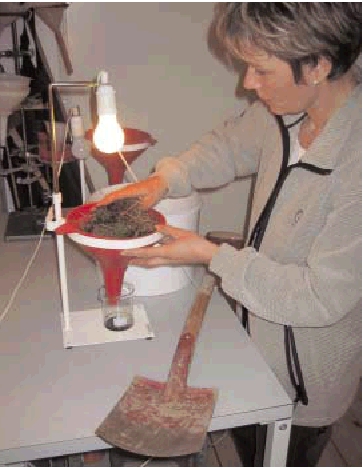
A soil sample from the topsoil is placed in the funnel. A lamp over it will gradually heat up the soil, causing the animals in the soil to try to escape the heat by crawling downwards. Finally, the animals will fall down into the glass under the funnel (within 24 hours).The animals can then be observed under magnification. Large springtails are an indicator of good biological conditions.
Education – Finnish Folk High Schools
By Kaisa Lindström, Finland
“A Silver Lady”- metaphor for education for sustainable development
One Estonian story deals with a silversmith who never succeeded in finding a wife. After living alone for years, he decides to make a wife from silver. So he makes a very beautiful silver wife, and he is very proud of himself. But when he has lived for a few days with this silver lady, he starts to become frustrated. There is no hope for companionship, and no possibility to share his ideas or everyday life matters with his new wife. He realises that without a mind, without a heart and without a spirit, his silver lady is just useless!
Words such as sustainable development and global citizenship seem to me similar to the silver lady - they are grand words but they have no spirit!
Folk high schools have special tools that can give this spirit to the »silver lady«.
I attended the World Summit on Sustainable Development in Johannesburg in August-September 2002, and in a panel discussion one participant analysed sustainable development as including three parts: ecology, society and spirit. I think the idea of giving spirit to the silver lady is very Grundtvigian. It is our responsibility to do so. Teachers and group leaders still do not know what sustainability really means: We need more teacher training. If teachers are not aware, how can they instil the necessary spirit?
We need better definitions of sustainable development, but it is useless to cry out for weak definitions. Nobody can come and tell us what the sustainable future looks like; we need to find the ideas together! When trying to find alternatives for the future, we can make choices and start to work for the best alternative.
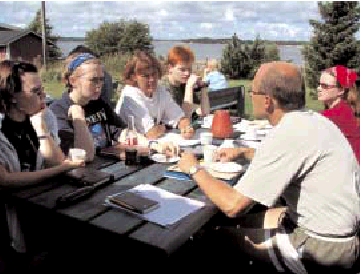
Otava Folk High School’s general education team working with the annual self-evaluation plan of education for sustainable development
Otava Folk High School is one of 91 folk high schools in Finland. They are rooted in the Danish folk high school movement, which started in the middle of the 19th century. Finnish folk high schools see themselves as free and independent institutions outside the official education system. Each folk high school is free to emphasise its own values, ideology and pedagogical objectives. Residential folk high schools offer long and short courses (from a couple of days to one year) and they can also provide consultancy and other services relating to their educational profile.
According to legislation, folk high schools are also authorised to offer certificate-oriented education and training, although the main emphasis is on non-formal education.
Grundtvigian folk high schools in Finland are considered to have the following dynamic criteria:
- they fulfil and complement the formal school system by bridging educational gaps
- they expand the variety of courses and educational programmes, e.g. they are responsible for educational biodiversity
- they offer alternative ways to learn
- they challenge the methods used in the formal school system by offering alternative ways to learn.
Otava Folk High School is a typical modern Grundtvigian folk high school, which is based on the following Grundtvigian values:
- The perspective of relative truth: truth can only be found by discussing together with others and by looking at phenomena from different perspectives.
- Open dialogue and interaction: dialogue is a way to learn together
- Democracy and empowerment: the first two values are not possible if someone wields power over others.
- The perspective of time: trialectic time views the past, present and future as tied together. We need “roots” to strengthen our identity and “wings” to face what is distant and strange.
The relative truth perspective highlights the need for knowing and reflecting on the different views of sustainability. The issues represent extremely complex social, political, economic, ecological, aesthetical and ethical aspects. Together, they clearly dictate a more sustainable approach to future development.
Open dialogue and critical thinking have always played a role in folk high school pedagogy. Dialogue means interacting, exchanging ideas, and learning together. Open dialogue is a basis for social and collaborative learning.
Critical thinking means challenging the present situation, defining the problems and reflecting upon our opinions. We learn about the issues involved and consider whether things can be done differently, and then we act together with others to change the present situation. Critical thinking also needs competence, and participants become competent by participating in the process.
Democracy and empowerment: In Grundt-vigian thinking, democracy includes the democratic society as well as the question of how to be democratic. This requires an educational/-learning environment where power grows from below and moves inwards from the edges to the centre. Equality is crucial in this process.
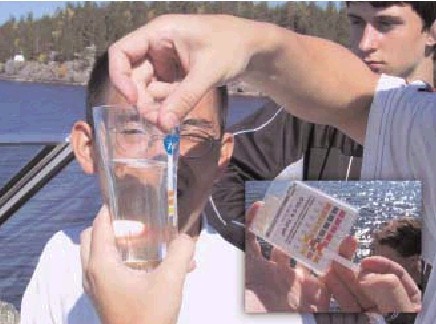
Otava Folk High School students dealing with water samples taken from Lake Saimaa
Open dialogue and open interaction play important roles in increasing democracy and equality. Empowerment is a result of a democratic learning environment, and leads to action. Involving politicians in the dialogue of sustainable development is important in order to show how democracy works and what global citizenship means.
Networks and action groups provide fruitful ground for education for sustainable development: They provide a context for a personal learning process, forums for working together, and an opportunity to become a member of a social network.
The trialectic time perspective builds a basis of sustainability. Present knowledge, a present situation or a present problem is always in a dialogue with a past and a future. Today’s problems are yesterday’s solutions. Environmental problems have increased as part of the development of human society. And the decisions we make now may cause problems for the future generation. But we can also learn from past mistakes. By showing that remote issues have local expressions which one can influence, it is possible to balance “distant” and “near” as well as promote empowerment.
As residential institutions, folk high schools offer an authentic environment for educating for sustainable development. They can behave as a microcosm of a sustainable community itself or find ways to go from plans to action.
Otava Folk High School offers many kinds of education programmes, from self-directed non-formal courses to vocational training and Open University courses. Its main area of expertise lies in modern media and open learning environments. According to the Otava core idea, the school is committed to promoting sustainable development and global citizenship, and to finding alternative ways for learning. The school aims at finding new target groups (groups with special needs) and at challenging methods of the formal school system, for instance developing participatory methods.
How does Otava Folk High School promote sustainable development?
- By running an accepted programme for education for sustainable development, where key elements and indicators have been written down.
- By having sustainable development mentioned in its core idea and in the curricula.
- By having taken the task of educational bio-diversity and filling educational gaps seriously.
- By having a self-evaluation system for education for sustainable development according to the indicators mentioned earlier (see chapter 2)
- By being active in projects which offer authentic learning opportunities for education for sustainable development, i.e. the Globe Project, the UNESCO Baltic Sea Project, the Active Citizenship Project, and the Grassroot-Leonardo Project
- By having taken on a role to activate other folk high schools in Finland and to promote networking with them.
Education
By Franziska von Gadow, Germany
Indicators for a sustainable development in the city of Flensburg
This project was developed by 10 students at Auguste-Viktoria-Schule in Flensburg, a town in northern Germany about 5 km from the Danish border. The students were about 18 years old. With their results they wanted to show politicians and other people who are responsible for the administration of the town the current development of Flensburg towards sustainability.
They used 24 indicators, which are listed below. In examining the indicators, the students gained very good experience as well as an overview of the ecological, social and economic situation of their own city. They began to feel responsible for their city and had a better feeling for the local Agenda 21 and its global aims.
The indicators are:
- Waste Minimisation: household waste measured as kg per person per year.
- Municipal waste measured as kg per inhabitant per year.
- Handling of non-renewable resources: land utilisation measured as % of entire acreage
- Conservation of the level of renewable resources: water consumption measured as litre per inhabitant per day.
- Use of energy: electric power consumption measured as kW/h per inhabitant.
- Mobility measured as number of vehicles per 1,000 inhabitants.
- Even distribution of work: unemployment rate in numbers of men and women and in %
- Degree of self-sufficiency: percentage of regional products at the farmers’ market.
- Balanced economic structure: employees paying social security.
- Stability of the price level: price index of rentals measured as cost per square meter.
- Sound structure of official budget: municipal debt in DM per inhabitant.
- Operational pollution control: enterprises with an eco-audit in numbers.
- Fair division of income: number per 1,000 inhabitants receiving assistance.
- Level of training and education: number per 1,000 employees.
- Balanced population and settlement structure: number per 1,000 inhabitants relocated.
- Cultural offers: participants in further and continuing education per 1,000 inhabitants.
- Health: number of overweight children.
- Volunteer commitment: number of registered associations per 1,000 inhabitants.
- Democratic commitment: voter turnout in % at municipal assembly elections.
- Commitment to international justice: municipal expenditure for joint development in % of the municipal budget.
- Women’s participation in public life: % women in the municipal assembly.
- Living conditions: municipal expenditure for improving the environment of children and youth.
After about four months of work, the students presented their results to the public in May 2002. They hope that other schools will follow and do the same research in their own town in order to obtain data for comparison:
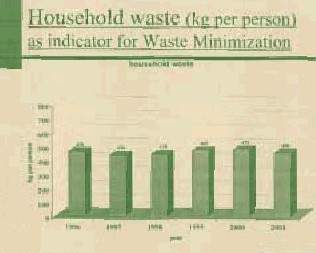
Household waste measured as kg per person per year
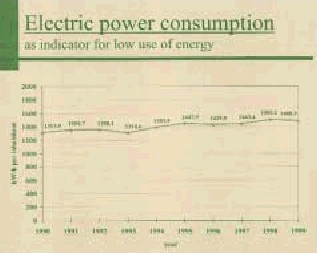
Electric power consumption measured as kW/h per inhabitant
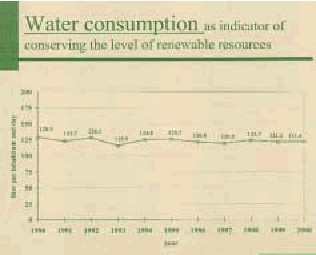
Water consumption measured as litre per inhabitant per day
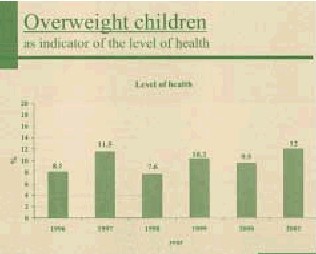
Health: number of overweight children
Energy
By Anna Figiel, Poland
Teacher’s reflections
With colleagues teaching biology, chemistry and computer science, we have been working together with students in the Project since 1989. Each project has been prepared by approximately 20–30 participants, who have worked in groups of two to four members. The groups have worked on various topics within one single field.
We have worked with ’Environmental History’ and dealt with two main topics: ’Energy’ and ’Food’. The energy topic included co-operation with biology and chemistry teachers Gudrun Ejlertsson and Clas Edlund from Österport-skolan in Ystad, Sweden, and Agnete Waagstein and Bodil Pedersen from Stenhus Gymnasium in Holbaek, Denmark, and also with chemistry and physics teachers from Carl Schurz Schule in Frankfurt am Main, Germany. The topic on food was dealt with in co-operation with Sten-hus Gymnasium only. The historical aspect was approached through information taken from books, archives, surveys and interviews with elderly people who remembered the information needed.
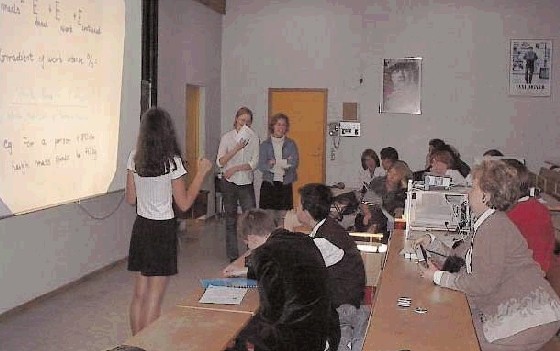
Polish and Danish students discussing energy, history and environment in Holbæk, Denmark 2002
Energy:
We started the work from the given topic. The students had to define their topics, such as ’The Sun and Solar Energy’, ’Thermal Energy’, ’Vitamin D’, ’Calories and Fashion’, etc. Students were very creative in the topics they wanted to prepare. I noticed an increasing eagerness during their work. They had to present information to the teachers about what they were going to do, and then we discussed how to do it. As the work progressed, new ideas appeared. In this way the work became very vivid and students became more and more involved. Sometimes they had to obtain special permission from the school authorities to gain access to some documents, offices or factories into which not everybody is allowed. This made them more curious and proud. They were able to become more familiar with research methods and felt a little like real scientists.
As some of the students took part in more than one project, I could observe that they were more skilful when working on the second one. They were more experienced and more self-confident. They knew what was good for the presentation, and what grabbed the attention of the audience. That is why they started working with computer CDs, which gave them the opportunity to make a more interesting presentation, which was also less stressful than talking and showing the data on an overhead projector.
In my opinion, this kind of group work, including co-operation with students from other countries and using foreign languages, is a great challenge. It gives people the opportunity to connect scientific investigations and to make study visits, for example to power plants, factories, and museums, both in our own country and in the country we are co-operating with. Students become aware of the ecological problems connected to the topic and the background for sustainability. They can find out what has been done during the last hundred years in the area they are investigating, they can discuss whether the changes have improved the situation or not, and they can suggest what could be done in the future.
What did not work in our projects?
In general, we did not have special class lessons for our work, and consequently the students came from different classes. It was almost impossible to gather all of them at the same time.
They worked on their own and discussed the problems either after the lessons or during the breaks. It would have been much easier if there had been a special ecological class. The only time the whole group was gathered together was for the presentation of results in the school Aula (assembly hall) for our headmistress, some teachers and English-speaking students as preparation for travelling to another country. Then we spent the time together abroad. The next time we could meet each other was when our guests came to us, presented their work and we organised some events together. Anyway, this kind of work with young people gives a lot of pleasure to both students and teachers. They make friends, and very often they maintain good relationships for a long time, not only writing letters or e-mails, but visiting each other as well.
Students’ reflections
Olga Madejska, Anna Karczewska, and Magdalena Leman tell about their project on vitamin D.
We gathered data on vitamins and healthy nutrition. Our sources were mainly the Internet, biology textbooks and encyclopaedias. We learned about the importance of vitamin D for bone growth and the necessity for the human organism to obtain and absorb calcium. We learned where and how vitamin D is produced and its main sources. We also became familiar with the terms ’ healthy’, ’balanced diet’ and ’osteoporosis’ - which is the result of the lack of calcium in the bones.
Preparing this project gave us not only factual knowledge about vitamins, but also about cooperation between students and the possibility to support each other, and with mutual help reach a certain goal.
We think such projects give young people great opportunities: to learn about other countries and cultures, to learn how to work as a team and also, which is maybe the most important, to learn something about ourselves and the environment on which we depend so much.
How we started the work
We started working in the Ecological Club almost immediately after entering Nowodworski Secondary School. During our biology classes we learnt all about the club, and students who wanted to join could sign up for it.
What was the study about? What themes were included?
The title of the project was “Energy, Environment, Man and History”. When talking about energy, all sorts of energy were taken into consideration. The topics were not only about energy used in industry, such as solar or geothermal energy, but also about nutrition and energy in our bodies. The projects took up such themes as “How the organism uses energy”, and “Anorexia and Obesity - Different Diets”.
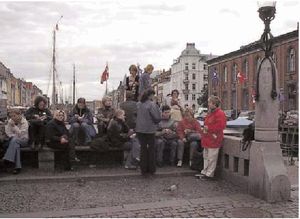
Energy is also utilised in the human body. Krakow and Holbæk students in Copenhagen
What were the results of the discussion?
First, we dealt with alternative sources of energy. Both Polish and Danish students raised this issue. The most interesting thing for me was the ideas of solar energy and wind energy produced by wind turbines. While visiting Holbaek in Denmark, we could see wind turbines, this source of energy being quite popular there due to the appropriate climate. It turns out to be an extremely good way of obtaining power, since it does not pollute the air at all. The same goes for solar energy. Solar energy is already used in countries where the climate allows for it. Unfortunately, in Poland, none of these ideas are possible for two reasons: climate and money, since building wind turbines or screens for catching solar energy is expensive. In Poland, another matter of concern is that not many people care about the environment compared to western countries. It will probably change in a few years, but now (2003) the situation is not very good.
The second part of the project was about the way the human organism utilises energy. I found this part more interesting since I think we are always more curious about the way our body functions. Moreover, the part concerning different diets enabled us to understand what healthy or unhealthy food we eat. It was a great opportunity to learn more about it and, if necessary, to change our habits so that we become healthier. What is more, we saw what the human organism does with the nutrients it receives and also what makes people become slim or fat, as probably not everyone knows the reasons for this.
Success or failure
Matylda Stryczniewicz tells about exchange visits:
Exchange visits are valuable, and twinning with partner schools abroad is a very good way to learn about different subjects connected to ecology. It is for sure more effective than sitting at school. We always remember things better when we prepare something out of our own interest.
During this project, all the topics related to the energy in our body were extremely interesting for me and that is why I am really glad I could take part in the exchange.
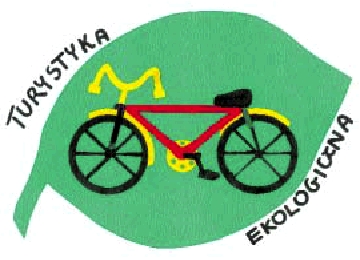
Beoita Joiwis, Poland
Energy Efficiency Measures in Raguva Secondary School
By Sigitas Zudys, Lithuania
Initiative
Activities towards sustainability in the secondary school of the settlement of Raguva began in 1999 within a national project entitled School Agenda 21. The main goal of the project is to encourage students to identify, investigate and take action to prevent and solve environmental and related problems in their own community. It includes
- integration of sustainable development/real-life problems into the school curriculum
- initiation of practical activities stimulating changes of lifestyle
- partnership with community organisations
The pupils‘ initiatives and their participation in planning the learning process and school life are essential components of the project.
During the 2002-2003 school year, children from Raguva Secondary School chose several topics for practical activities, i.e. changes in consumer habits, energy saving, improvement of the living environment, and waste management. The problems selected were discussed also by the team of teachers and incorporated into relevant curricula for the following subjects: geography, Lithuanian language, chemistry, physics, technology and biology. Links with national standards according to the age group were clarified. In this way practical activities were connected with the learning in the classroom. This also brought an extra value to the education process.
Investigation
Energy is essential to improve the quality of life. In our daily lives we use energy for many purposes: to light and heat the buildings we live and work in, to cook food, and to make various electrical appliances work. It makes life comfortable for us, but is it enough to be a conscious consumer?
Energy efficiency has been identified as a priority area for the Energy Sector of Baltic 21 (see page 16). What can be done to achieve this purpose at school and at home?
An investigation into electricity consumption was initiated by the eco-group, consisting of 9 students aged 13 to 17:
- How much electricity do we use at the school?
- How much does it cost?
- What electric appliances consume most energy?
- Are our habits in using electricity sustainable?
- What efficiency measures could be implemented?
These were the questions asked by pupils.
The background information on various ways to produce energy was discussed in the classroom. Production was related to economic, social and environmental issues. Problems and perspectives connected with the decommission-ing of Ignalina Nuclear Power Plan (the main provider of electricity in Lithuania) were covered as well.
The eco-group performed an electricity audit of the school.
According to the assessment, electricity is used primarily for lighting the school premises. At the school there are:
- 108 luminescence bulbs, installed power 2,600 W
- 630 heat bulbs, installed power 91,210 W
- 70,806 kWh in total was consumed for school lighting during 2002
- The total cost for the electricity consumed in 2002 was 20,476 LTL (5,930 EURO
In some classrooms the illumination does not meet the hygiene requirements because the power of the bulbs used is lower than required.
The pupils also evaluated their personal lifestyle according to the following questionnaire:
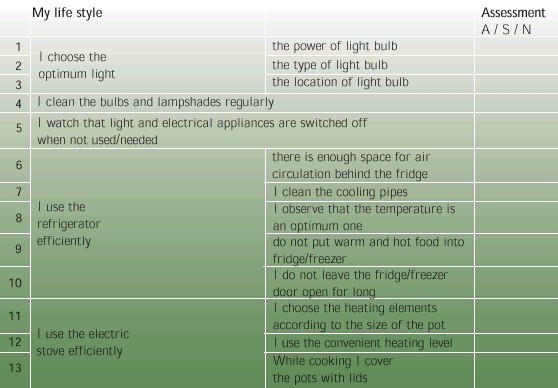
A - always, S - sometimes, N - never
In the beginning children were satisfied with their behaviour. It was expected that the most important (and simple) measure is just to switch off the light and other electric appliances when they are not needed. However, after the work was finished, children found space to improve their habits as well.
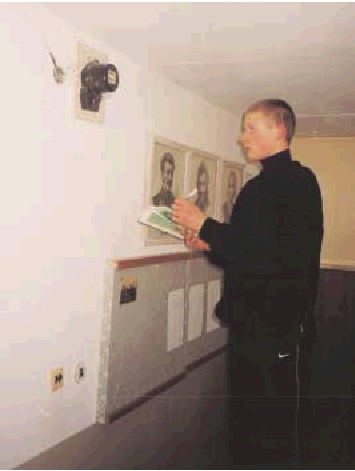
The electricity meter in the classroom was read regularly for one month
The challenge was to find out how to save electricity and at the same time improve hygiene conditions. It should be done not only by behaving appropriately, but also by implementing new efficiency measures at the school.
The pupils collected and analysed information about the characteristics and efficient use of various appliances. The parameters of available light bulbs were particularly investigated.
Different locations of the lamps were considered to provide appropriate illumination. The colours of walls and the position of windows were taken into account. It was decided to install additional switches in order to switch off the lamps close to the window or turn on the light at the blackboard. The municipal specialist in energy and a doctor were invited as consultants. Recommendations for changes in school lighting were developed.
Results
It was decided by the eco-group to carry out the following experiment: Two identical classrooms, geography and physics, were selected. In the geography lab, all heat bulbs were replaced by energy-saving ones. Electricity consumption in each classroom was registered over a period of one month. The geography lab was used for approximately 36 hours, the physics lab for approximately 38 hours. The result was surprising, even for those who measured the results. The difference in electricity consumption was tremendous, i.e. 87 kWh and 17.3 kWh. It is estimated that investments in new light bulbs will be returned within 5-6 years.
A reconstruction plan for school lighting supported by the relevant calculations was submitted to the municipality.
Families of the eco-group members were informed about the activities at the school. Nine families decided to carry out an energy audit at home, based on which they started to implement various energy efficiency measures.
The eco-group presented their results at a conference at the community centre of the settlement of Raguva. Schoolchildren, community members and officials from the municipality of the Panevezys region participated.
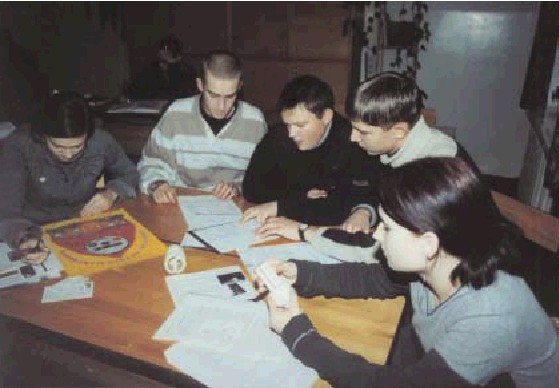
Pupils discuss the best choice of light bulbs
Various aspects were discussed:
- What energy efficiency measures are realistic?
- Why is it important for me to use less electricity?
- Will it affect my living conditions and health?
- What economic benefits will be achieved?
- What is the purpose of energy saving for my family and for the local community?
- How does it contribute to the saving of natural resources and to the protection of the environment?
The pupils found the practical activities interesting and stimulating, as it made them think more about the consequences and the broad impact of their personal lifestyle.
They also pointed out that they enjoyed working together in the eco-group, and co-operating with their parents as well.
Sustainable Use of the Sea
- for food, for medicine, for energy ...
By Hans Jørgen Bruun Olesen, Denmark
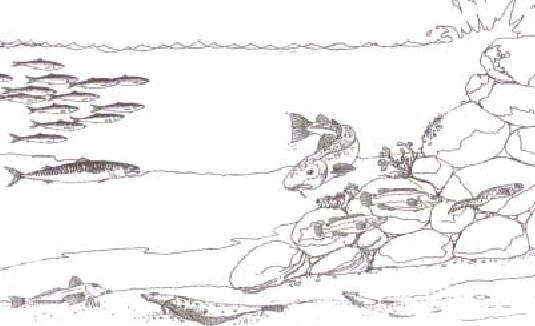
- Is it OK to catch fish in order to produce medicine?
- It is OK to catch fish in order to produce fish-meal for animals?
- Is it OK to catch fish for food?
- Is it OK to catch fish?
- Is it OK to discharge waste water into the sea?
- Is it OK to place wind turbines in the sea?
- Is it OK &
Esbjerg Gymnasium is situated in Esbjerg, on the west coast of Jutland facing the North Sea. Fishery was one main reason for establishing the city, another was the need after World War II for a major harbour facing westwards towards England, traditionally one of the main markets for Danish dairy and other agricultural products. Fishery still plays a very important role for the entire society. South of Esbjerg, all the way to Holland, lies the Wadden Sea, a precious and special tidal zone with a unique biodiversity and with outstanding ecological importance, not least for migrating birds, such as waders and geese.
To understand fishery and sustainable use of the oceans, and to discuss some of the questions above, we introduced our 1st year students (aged 16) to the following studies:
Fisheries:
The students were divided into three groups, which all managed the following three elements during a full 8-hour day:
- A visit to the Aquarium at the Fishery and Maritime Museum in Esbjerg to study fish species, fish adaptation, camouflage and behaviour.
- A visit to the local fishmeal factory - one of the main industries in the local area. The students spent two hours on the working process. They followed the fish from the catch, determining the species, and finding out what is done with the fish in the factory and what the end-products are, e.g. fish oil for medicine, and fishmeal for domestic animals and fish farming.
- A fishing boat trip to study fishing techniques. Fishing with trawl for fish and animals close to the sea bottom. The students identified the fishes and animals caught.
In consultation with fishery organisations, we are able to elaborate further on the following:
- The different species caught
- Problems related to the catch - such as dioxin in fishmeal, but also the cost of removing dioxin from fish, e.g. 100 million DKK to remove 1g of dioxin!
- The quantities caught
- The methods used - how they catch the fish: blue mussels (Mytilus edulis) and shrimp
- Regulations - net mashes and quotas
- Comparisons between Danish fishery and other North Sea countries.
Wadden Sea examinations
Through visits to the Wadden Sea, we perform the following tasks:
- We investigate the species of animals.
- We measure the water level at low tide and high tide, and the consequent tidal impact on the flats in the working period.
- We find out where the animals live and the plants grow, compared to the "normal" water level.
- We find out what the animals eat.
- We make food chains.
- We compare fishery.
- The students also make examinations of the marshlands.
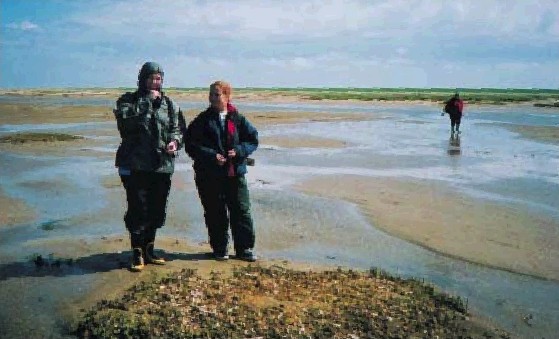
Low tide at the Wadden Sea. Some plants are well adapted as pioneers to create marshland by growing directly in high-salinity water
Waste water treatment
In Esbjerg, we have two waste water treatment plants providing mechanical, biological and chemical treatment. The objective is to follow the water cycle from tap water (drinking water) to waste water, to the waste water treatment plant, and to the recipient, the Wadden Sea and the North Sea.
We study and discuss the effects of waste water in the sea.
The students think the visit is smelly, but they are very interested in the processes.
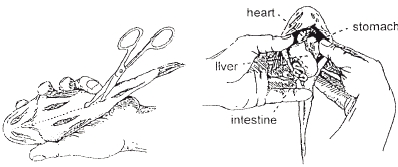
Offshore: energy and oil pollution
Objective: to study the effects of the offshore oil industry on marine organisms and on beaches used for recreation. Unfortunately, there is often oil pollution somewhere in the world that we can compare with.
Wind turbines in the sea is a new issue: There are 60-80 wind turbines constructed in the North Sea: While we achieve energy without pollution, what is the impact on fishery, on tourism, etc? We also try to look at some of the issues from a historical perspective.
Here is what the students Dennis Jensen, Niels Ole Jessen, and Flemming Nguyen thought of the fishery studies:
At the ’Fisheries and Maritime Museum’ in Esbjerg we did some research on the behaviour and adaptation of fish. The only important thing to a fish is finding nourishment without being eaten itself. That is why fish are endowed with different qualities such as camouflage, speed, the ability to make sudden attacks, etc.
Other examples of adaptations are the agility and streamlined build which fish have developed. These qualities can be used for hunting as well as for defending itself.
Dissection:
At the laboratory section at the ’Fisheries and Maritime Museum’ in Esbjerg, they gave us two different fish: a sculpin (Myoxocephalus scor-pius) and a herring (Clupea harengus). Our assignment was to find similarities and differences between the two fish.
Our first observation was the form of the fish: the herring is more oval while the sculpin is almost triangular. Let us take a closer look at the herring. The shape of the herring shows that it is a fast fish that swims a great deal. The small size of its head facilitates this activity. Further conclusions could be drawn after examining the inside of the fish. A striking difference between the two fish was that no swimming bladder was found inside the sculpin. A swimming bladder shows that the herring is often near the surface of the water, where such fish also feed.
We very quickly discovered that the sculpin lives on the bottom of the sea. Its stomach contained a funny little lump, which later turned out to be a crab. The fact that it has neither a swimming bladder nor contains various kinds of aquatic plants tells us that it lives on the bottom of the sea. We can also conclude the sculpin feeds by making sudden attacks, where great speed is required to catch its prey. However, the sculpin is a poor long-distance swimmer, which is indicated by the size of its gigantic head.
Fishing:
On “E1 Claus Soerensen”, which took us on our fishing expedition: in the waters between Fanø and Skallingen, we caught the following fish and animals at a depth of 7-8 m: Flounder (Plaichthys flésus), whiting (Merlangius merlan-gus), sculpin (Myoxocephalus scorpius), pipefish (Siphonóstoma týphle), butterfish (Phólis gunéllus), viviparous blenny (Zoarces vivipa-rus), sand goby (Pomatoschistus minutus), beach burbot (Cárcinus maenas), swimming crab (Portúnus depurátor), edible crab (Cáncer pagúrus), hermit crab (Eupagúrus bernhárdus), shrimp (Crángon vulgáris), and starfish (Astérias rúbens).
We think it has been an interesting assignment, and we can conclude and answer the opening questions:
- Yes, it is OK to catch fish in order to produce medicine. Medicine might even be more important than food and fodder. If fishery is not sustainable and the fish cannot regenerate, then fish for food should be reduced.
- It is OK to catch fish to produce fishmeal if the animals that are fed with fishmeal also eat fish in nature! But if animals are fed with fish-meal and fish is not part of their ordinary diet, then we oppose it for ethical reasons!
- It is OK to catch fish for food as man has eaten fish throughout history. We need food, but the fish stocks should be able to regenerate.
- It is OK to catch fish as it is healthy food. There is a problem with quotas because fishermen catch too many fish and have to throw them overboard. These fish will die, so the techniques have to be made less harmful.
- It is OK to discharge waste water into the sea after proper treatment. Waste water must not have a negative impact on the ecosystem, and we have to get rid of it somehow.
- It is definitely a splendid idea to place wind turbines in the sea. It is less harmful than Vestkraft power station!
- It is OK to have fish farms if the species is endangered. But there is a problem of nutrients, antibiotics and other pollutants being discharged from the farm, so the water quality of aquafarms has to be controlled.
Fisheries in Nexø, Bornholm
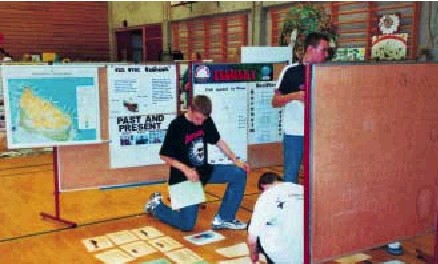
We have worked with the subject of »fishery« in Nexø. There is a factory there that produces tins of cod roe, smoked cod liver and fish balls made of cod meat. The production of cod liver started during World War II, when fishermen were instructed in how to land the cod liver and make cod liver oil.
The development of Nexø harbour was examined. The harbour saw two major enlargement projects in 1964 and 1979, and was described as the »centre of fishery in the Baltic Sea«. The following years saw major activities in the harbour. At the end of the 1980‘s, however, the adventure was over, brought to an end by the imposition of strict quotas. Today, there are only about 50 cutters fishing from Nexø.
The main species caught are cod, herring, flounder, sprat and salmon. How much the fishermen are allowed to catch depends on the quotas, which are determined every year in Warsaw. However, fishery has stabilised in recent years.
A marine biologist told us that the conditions for cod are rather good, but more oxygen would improve the conditions together with storms from the west, which would bring fresh salt water into the Baltic Sea. The worst pollution is caused by nitrogen, and this will only improve in 20-30 years if the pollution stops now.
We also tried to have a look at the future: How can we have a more sustainable fishery in the Baltic Sea? Some of the answers are: less pollution, less use of fertiliser in agriculture, more water treatment plants, larger meshes in trawls and nets, and sufficient quota.
The chairman of the Fishermen’s Association of Bornholm and Christiansø thinks that the situation will not change much in the years to come.
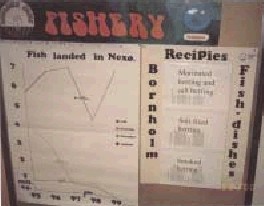
When no herring is caught in the Baltic Sea, it has an influence on the traditional recipes of Bornholm, a cultural heritage of importance for tourism
Fisheries in Kolobrzeg
By Maria Adamiak and Andrzej Kropidowski, Poland
Our school is in Kolobrzeg, a beautiful town situated in the mid-western part of the Polish seaside at the mouth of the Parseta River. It is a small but busy fishing and merchant port with a number of tourist boats and a marina. There are about five hundred 12–15 year-old students at our school. We have worked on ecology and environmental projects for a couple of years. We take part in national and international educational programmes and work for sustainable development, and our school has been involved in the Baltic Sea Project since 1999. Fishery has been chosen because it is very important for the development of our town and region.
About the research:
Fifteen students were involved and five research groups formed. Each group was given a specific task. The groups visited some fishing boats, a fish processing plant and a fish farm, and interviewed some anglers and people involved in the fish industry.
Here are the results of their research:
Sea fishing
Polish fishermen work not only in the Polish economic zone but also in the Swedish, Danish and German zones in accordance with international agreements. The most important fish species are cod, herring, sprat, plaice, mackerel, salmon and eel. Salmon and eel are migrant –marine and freshwater fish. The salmon feeds in the sea and reproduces in rivers, especially the ones that lead into the Baltic Sea – the Parseta, the Slupia, and the Wieprza rivers. The eel
feeds in rivers and reproduces in the Sargass Sea. The optimal environment for the reproduction of the cod is the deep waters north west of the island of Bornholm and north of the Gdansk Bay. The coasts of the Pomeranian and Gdansk Bays, the beaches and rocks of Ger-many, Denmark and Sweden are the main reproduction areas for the Baltic herring.
The most important fishing techniques and fishing gear are bottom trawls, bottom pair trawls (cod catches), pelagic trawls, pelagic pair trawls (herring, sprat), drifting nets (salmon) and hooks: bottom (plaice, eel, cod), under surface (salmon). The sprat accounts for the biggest percentage of marine catches (70-80%). It is mainly used for industrial needs to produce fodder. The other species are used as food sold fresh in shops, but most are processed in fish processing plants, where the fish is smoked, frozen or breaded. Preserves, salads, fish spread, canned food, marinades and pickled fish are also produced. Some products are sold locally, and some are exported.
Marine fishery is very important for our town and its people. Lots of people work as fishermen and their families depend on their incomes. There are several fish processing plants in the region, where a few hundred people are employed. Although they do not earn much money, they are happy; they can make a living, and they hope not to join the ranks of the unemployed, currently 30% of the population.
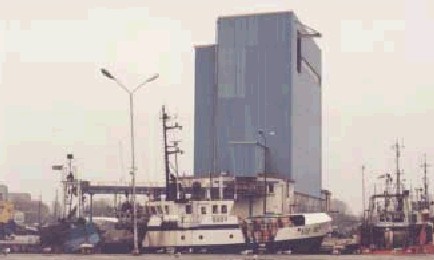
Fishery is very important for Kolobrzeg
Aquafarms
There are several ’fish farms’ in our area where carp and trout are bred. The trout needs clean, well-oxygenated, cool water. It is very vulnerable to infections and therefore it is much more difficult to breed than the carp. It is fed with wet food (sea fish) and dry food (granules made on the basis of fish meal imported from Den-mark). Because of abrasions trouts become infected with mycosis, sometimes suffering gill inflammation. When the temperature of the water falls below 10ºC they can get the VHS disease and that is the end of the farm, as there is no effective remedy for the disease. The fish from aquafarms are bred for food, and are especially popular here at Christmas.
Angling
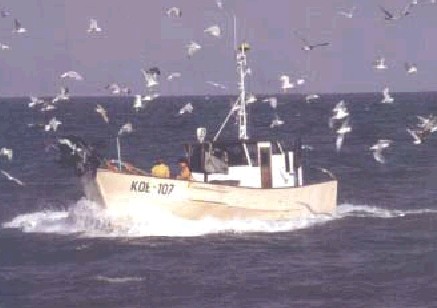
Angling is very popular in Kolobrzeg due to the desire for hunting, for recreation, for sports and competitions. Anglers fish in the Parseta River and in the sea. They catch salmon, salmon trout, pike, bream, perch, roach, burbot and other fish. All the species (except for the eel) reproduce in the river or on the old riverbeds. Most of them feed in the river. The salmon and the trout feed in the sea, the perch and the sea. Only 10% of fish is caught for economic reasons.
Sustainable fishery
– Protective measures taken
Delimitations on catches are set by the Ministry of Agriculture and the Development of Rural Areas. Poaching has to be effectively prevented and stopped. Fish stocks of salmon and trout salmon have to be continuously replenished.
Other protection acts
-
Delimitations of type and amount of fishing gear depending on the size of fishing boat (the length of nets, number of hooks, diversity).
- Waste water from fishing boats is passed on to special locations and then recycled.
- Every owner of a fishing boat needs to work out his own ’Oil spill protection plan’.
- Any attempts to interfere with river ecosystems should be stopped/banned (dams, river straightening, etc).
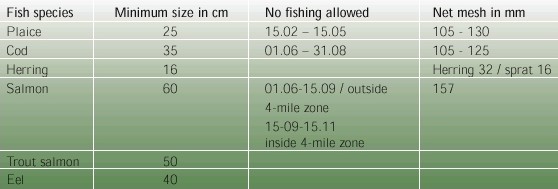
Fish stock viability indicators
Fish stock research is carried out mainly by the Sea Fishing Institute in Gdynia. The quality of eggs, fry and scales is examined. What is important is not how many eggs hatch into fry, but how many fry grow large enough to be caught. Environmental research – the salinity of waters, the amount of oxygen, the amount of food (plankton, other fishes), water pollution.
The fishing forecast
According to scientists, catches in the Baltic Sea should not exceed one million tonnes a year. The amount caught should not endanger the sea’s biological balance. The Baltic fish stock consists of small pelagic fishes, i.e. herring, sprat – 80%, cod – 10%, and other species – 10%.
The catches presented in the forecast for 2003 (about 120,000 tonnes) in the Polish Economic Zone will not be increased after 2004.
There will probably be more limitations on cod catches. The stock of cod is rapidly decreasing due to overfishing and fishing out small fishes. Fishery is a very important aspect of our lives. It gives us work, income, food and pleasure. We who live by the sea are well aware of this. Along with tourism, it is the core of the re-gion‘s economy. But we should be very careful when exploiting the resources of the sea as there are limits everywhere.
The biggest dangers are water pollution and overfishing. It is quite natural for people who are in the fish industry to get as much as possible from the sea.
At the same time, paradoxically, they realise that overfishing will lead to the end, but they are unable to stop it.
Therefore, others have to take action to stop it for them. More and more people should care about the sea and its limited resources, and then put pressure on their parliamentary representatives to take the necessary steps against the problems mentioned.
Forestry – Orchids and Biodiversity
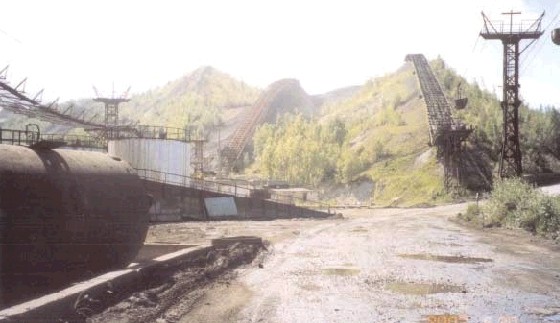
Technogenic landscape: Ash mountain created by the chemical industry in Kohtla-Järve
Kohtla-Järve Gymnasium is situated in Ida-Viru-maa, where there are many different industrial landscapes because of the oil shale and chemical industry. We were told about orchids which grow on our ash mountains through previous research work conducted by students from our school. We decided to find out if orchids also grow on other industrial landscapes.
We divided the industrial landscapes into four groups according to origin
- Ash mountains created by the chemical industry in Kohtla-Järve
- Ash mountains created by the power station in Ahtme
- Gangue mountains near Kohtla-Järve
- Recultivated open pits in Kohtla-Nõmme
We arranged six expeditions to these industrial landscapes in June and July 2002, in an effort to identify what species of orchids grow there. As the orchids are under nature preservation, we cannot collect them. Nevertheless, we took pictures of the plants that we found, marked the places where they grow on the maps and charted the landscape.
The industrial landscapes are recultivated (wooded) and the oldest forests are about 40 years old.
On chemical industry ash mountains we found five different kinds of orchids: Orchis militaris, Dactylorhiza incarnata, Orchis maculata, Epipactis atrorubens and Epipactis helleborine.
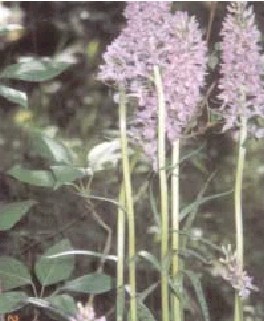
Orchis maculata thrives on the chemical ash mountain
On power station ash mountains we found three kinds of orchids: Dactylorhiza baltika, Epipactis palustris and Epipactis helleborine.
On Kukruse gangue mountains only one sort of orchid – Dactylorhiza baltica – was observed.
In the quarry areas in Kohtla we found more sorts of orchids than at the other places: Cypripedium calceolus, Dactylorhiza fuchii, Plathantera bifolia, Listera orata, Epipactis atrorubens and Epipactis helleborine.
We found altogether 11 different species of orchids. Two species belong to category II, and 9 species to category III of the nature preservation plant list.
The occurrence of orchids is most varied in the parts of industrial landscapes that are wooded. Sinivoore gangue mountains are covered with plants halfway up, but orchids do not grow there. Also, orchids do not grow in treeless parts of the power station ash mountains. Therefore, orchids like to grow on the industrial landscapes, where the soil is full of lime.
Orchids from industrial landscapes have no natural enemy – such as wild boar, which eat their tubers. That is why we found about 200 Orchis militaris plants in a 2,500 m² area of chemical industry ash mountain.
Recultivated industrial landscapes change the scenery, and they can be used for sports and hiking. Hikers and people who appreciate nature enjoy the blooming of the beautiful orchids in industrial landscapes.
In the future we plan to take soil samples, the goal being to examine the soil ecosystems in the technogenic landscapes in the hope of understanding why orchids like technogenic landscapes.
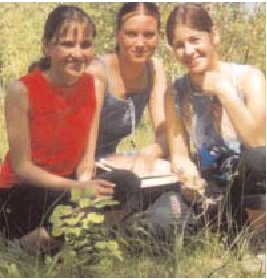
Students from Kohtla-Järve Gymnasium searching for orchids on wooded ash mountains
SUSDEED – SUSTAINABLE DEVELOPMENT IN EDUCATION
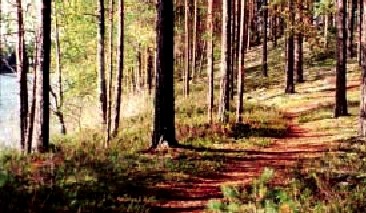
Finnish Esker forest
By Risto Hamari, Finland
Langinkoski upper secondary school in Kotka has participated in the Baltic Sea Project since 1989 when the project was still at the planning stage in Finland. Ever since, the school has participated in different activities of the project. The work culminated in 1992 when the school was responsible for arranging the first international conference of the Project entitled “Students Working for the Baltic Sea”. This conference marked the end of Finland’s host period (see page 4).
Within the framework of the Baltic Sea Project, two topics have attracted major interest in Langinkoski. One is the River Kymijoki, which runs into the Baltic Sea just near the school, and the other topic is forests. The importance of forests is self-evident in Finland, and in the county of Kymenlaakso even more so because many wood processing industries are situated here. The area is well known for its pulp and paper industry as well as its sawmills. Most families depend on forests for their living, directly and indirectly. Accordingly, educational aspects of forests and running waters have been our main contribution in national and international co-operation, the Baltic Sea Project included.
All the main types of boreal forests are present near our school: dry upland forests with Cal-luna vulgaris and Vaccinium vitis-idaea as the dominant species; moist upland forests dominated by Vaccinium myrtillus, and grass-herb forests dominated by Oxalis acetosella. The study of forest ecosystems includes analyses of trees, bushes, herbs, birds, mammals, insects and other invertebrates.
There was great interest in developing environmental education more in the direction of education for sustainable development. Encouraged by the National Board of Education in Fin-land, the school asked other interested schools to join in an EU project announced by DG XI (1997-2000). There were many interested schools/institutions throughout Europe and the project started with a network of six nations and about 30 schools/institutions. Several schools worked together in local units, which partly explains the high number of schools in the project.
The aims of the SUSDEED project were ambitious: to study and clarify the concept of sustainability in education, to create European modules for education for sustainable development, and to improve the environmental management of schools.
Schools and universities in interaction
In order to fulfil the first task, a decision was made to write a book about the development of the concept of “sustainable development”. Dr. J. Raumolin from the University of Helsinki kindly accepted the task of writing the book. He also participated in all the meetings during the project and the participants obtained information about the process.
One of the most interesting parts of the project, at least for the participants, was the preparation of teaching modules. Every single unit (consisting of one to seven schools/institutions working together) chose an aspect which was both relevant and interesting from their point of view. Of course, thorough discussions took place on the proposals made by the participants. The attempt was to cover several aspects of sustainability and at the same time create a logical entity. In our Kotka unit, seven schools and institutions worked together, and the students visited each of these institutions during the course. The theme for the course was sustainable forestry. All the different aspects of the whole lifespan of the wood were dealt with -from the seed to waste products: Forest ecology - Management in forestry -Multiple use of forests - Forest aesthetics - Industry based on forest products - Logistics of timber, pulp and paper - Woodwork - Lifecycle assessment of products.
Our results on forests were formulated in a small booklet, “The Forest Course”. The results were included in the final booklet together with all other contributions, which dealt with various aspects of sustainability, such as sustainable tourism: the impact of tourism in wetlands (Rantalakeus unit in the Bothnian Bay), and the influence of tourism on local people (the unit in the Canary Islands, Spain).
Urban areas were studied in Greifswald, Ger-many. Interest here focused on the reconstruction of an old, historical city centre. In Leeds, Great Britain, the restoration of a park area after construction works was the topic of the follow-up study.
The Baltic Sea was in focus in several places. In Kokkola, Finland, the quality of the waters was studied in an aqua course. In Kempele, Finland, the swift change after the land uplift and the use of primary meadowlands for grazing was one of point of interest. In Kotka, the study of water purification systems in the pulp industry was part of the forestry course, and in Landskrona, Sweden, the topic was marine ecology. In Greifswald, the harbour area linked the unit’s interest to the Baltic Sea as well.
Other important themes dealt with included energy saving (Alzey, Germany), recreation areas (Ludwigshafen, Germany), traditional and ecological agriculture (Landau, Germany), biological diversity (Lyon, France) and environmental news in local radio networks (Canary Islands unit).
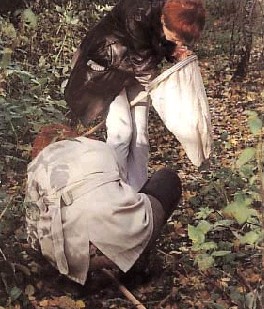
ield work in the Finnish forest
As a result of all these activities, the booklet “Environmental Courses and Sustainable Schools” plus a CD-rom was published and distributed to the participants.
Discussion
Sustainable development is a very complicated concept. Accordingly, education for sustainability is difficult and needs innovative perspectives that are interdisciplinary in nature. Conventional school work does not adequately support this kind of approach.
One of the criticisms made at the end of the project was that most of the activities had to be extracurricular and only a limited number of students wanted or could take part in them. One of the schools could not activate students for the practical work at all, even though their plan was quite interesting and should have been motivating. The conclusion is that more flexibility is needed if school work is really to form a significant part of the project activities.
In some cases the results gained from the study were obvious: The environment is in bad condition. The official parameters out of the school also express the same. It is hard for young people to understand why nothing has been done – as they say - to improve the situation. There is still a great deal of lip service paid in the field of environmental policy!
Many positive reactions could be mentioned. Students participating in the project expressed their interest for working in a different way from the school‘s everyday routine. Teachers were inspired by the international co-operation and by the opportunity to find out what others are do-
ing in education for sustainable development. Their sincere hope was to continue the project and strengthen the relationship between new partners. Unfortunately, and because of changed procedure in the EU, this was no longer possible under DG XI. One of the positive experiences was also the help of modern technology in facilitating communication between the participating units.
Multiplier effect
Our results serve as inspiration for new activities and the creation of a network of schools working for a better Gulf of Finland. In this network more than 10 Finnish, Estonian and Russian schools co-operate as a regional network for better conditions in the Baltic Sea. Their interest is directed to the rivers running into the Baltic Sea.
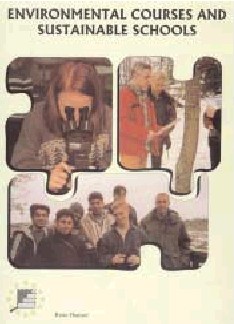
Soils in Poland
By Danuta Madroszkieiwcz, Poland
Glogow is one of the main towns situated in the Glogow - Legnica Copper Basin. Copper is found in soils in a one-metre layer covering altogether 600,000 km2 and stretching from Great Britain, Holland and Germany to our position in Poland. Today, extraction and processing takes place only in Poland, where the soils contain approximately 3% copper. Copper is used industrially due to its enormous conductivity, especially in the electricity and electronic industries.
The smelting and flotation processes, however, are harmful to natural environments, especially aquatic ecosystems, and also to the air, the soils, and consequently to the whole food chain: plants animals man. Copper in man causes health problems, such as nausea and diarrhoea, and with increasing concentrations the liver tissues and other organs may be damaged.
Our school decided to examine the soils in our local area as part of a joint Comenius project with Polokowice, another UNESCO ASP-net school. Our ecological classes followed the special educational programme called “Protection of Environment” with the main objective being to prevent environmental pollution and identify solutions. Two copper smelters, Glogow I and Glogow II, are situated 7 km to the west of Glogow, in an area called Zukowice. Glogow is heavily polluted by dust and gas, which blows directly from the smelters and is carried by western winds. Glogow is thus constantly exposed to chemicals from the smelters, despite the fact that Glogow has many parks and trees that serve as natural filters. We tested soil samples from the town of Glo-gow, from an area near Glogow I in Zukowice and in a protected area called Dalkow Hills.
We found many heavy metals - copper (Cu), lead (Pb), zinc (Zn) - in the air, in the water and in the soils. The situation is gradually improving because of considerable financial support for environmental protection.
The area near Glogow I was most contaminated. The samples were taken from a special strip of soil surrounding the industrial plant. To reduce the pollution problems, the area has been densely forested with poplar trees, especially Populus canadensis and Populus serotina as these species are tolerant to air pollution. No other vegetation can grow here except some mosses, algae and a few species of grass -Agropyron repens for one. Heavy metals cause soil degradation due to the harmful effects of heavy metals on all living organisms.
Dalkow Hills is called “Glogow’s green lungs” because of its many forests and nature sanctuaries.
Within the programme we dealt with the structure and texture of soils, processes of importance for making soils, degradation factors and nature protection.
The waste problem is also connected to soils, and therefore we arranged a meeting with town council officials. The officials gave a presentation of the recycling plant: Every inhabitant in Glogow produces 340 kg of waste annually. We went to the municipal dump - a sad sight. We saw litter drifting, not segregated at all. There was a pile of industrial waste, too, called “Sniezka”, which is the name of the highest peak in the Polish Sudety Mountains!
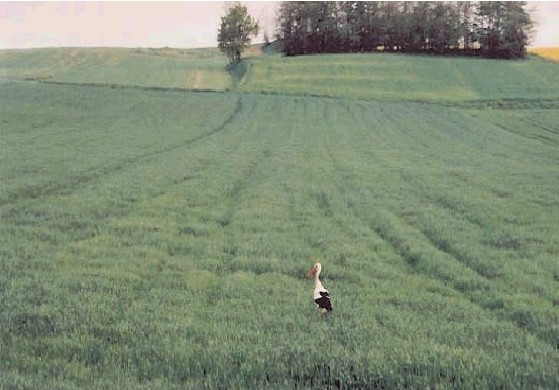
Sustainable development?
At least the white stork can still be observed in Polish fields
We also went to the after-flotation reservoirs “The Iron Bridge” with the remains from the copper-enriching process. The process severely damages the environment despite the fact that the reservoirs look interesting from a bird’s-eye view (further information in Learners’ Guide 4, Rivers, page 186).
We have therefore started collecting waste for recycling products, such as aluminium cans and paper!
To sum up our work, we presented our results at the International Earth Day, where the drama performance “Ecological tramps - how to recycle” showed that the participants had gained knowledge through the work.
We summed up our ideas on Polish soils in the following resolution:
To protect Polish soils we should:
- educate consumers on healthy food.
- eliminate the cultivation of plants for human consumption near contaminated areas and introduce industrial plants such as flax (Linum) and/or trees.
- prevent fruit and vegetables being grown in contaminated areas and bring in products from uncontaminated areas.
- propagate crop rotation and sustainable methods for removing weeds.
- minimise pesticides and fertilisers, and increase knowledge on organic farming.
Do we need another planet?
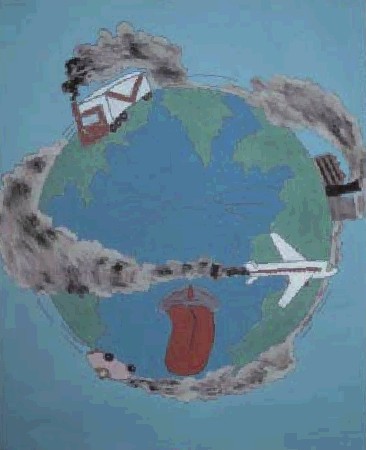
Poster made by students from Zespol Szkol Ogolnoksztalcacych No. 6, Gdansk, Poland
Industry – Invitation: Travel St. Petersburg with us
By Anna Obukhovskaya, Irina Krichevskaya, Alexei Pryalukhin, Maria Melnikova, Polina Ignatyeva and Xenia Zakharova, St. Petersburg, Russia
The hustle and bustle of daily routines surround us as we run through the streets of our native city, not noticing its beauty. There is history near us, yet we do not hear its pulse. Many people speak with love of this city, even without knowing it well: How is it possible to appreciate what you know so little?
Where should we begin?
St. Petersburg is so big, so different and so full of contrasts. It is the powerful current of the river Neva; it is majestic architecture, golden spires reaching the sky, temples and monuments. It is silence and beauty along its river banks and city channels, relaxation and time for reflection in the corners of its many gardens and parks.
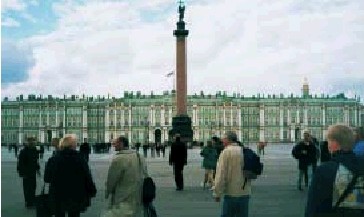
St. Petersburg has majestic architecture
But it is also the hostile cosmopolitan industrial city of grey concrete blocks, huge factories and plants, hidden behind long characterless walls; it is chimneys and emissions, busy harbours with neverending traffic.
Our school, no 179, is located in the northern part of the city. It is rather big with 1,300 pupils from the 1st to the 11th form. The buildings are well-equipped with laboratories and computer classes. Our main focus is on the combination of environment and medicine, humanities and economy.
Many students in the 8th form and onwards who are interested in medicine, ecology and scientific research join the “Senior Pupils’ Club”. Research work is done voluntarily and outside ordinary lessons, and is difficult and demanding. However, our students are guided by teachers and researchers in a personally-oriented way based on project work, investigations and technology, and their motivation is very high.
Before joining the Senior Pupils’ Club, pupils have certain obligations at different class levels designed to gradually develop their attitude towards sustainable development.
When pupils enter the 5th - 7th forms they have a project on “Energy Saving”, and each autumn and spring the 7th and 8th forms conduct a clean-up operation of the park areas along the banks of the Murinsky Stream, approximately 1-2 km away from our school.
They also clean up the area of the important memorial park of Piskaryovskoye, 12 km from our school. Piskaryovskoye Memorial Cemetery is the necropolis of Leningraders who died during the 1941-1943 siege. During the siege more than 740,000 people in St. Petersburg died of starvation and more than 16,000 people were killed in air raids and bombings. Today, delegations from all countries bring flowers to this place.
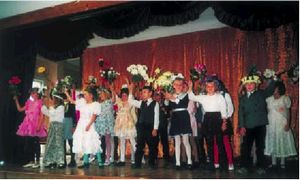
Flower festival: At primary level, at the age of 7-10 years, children learn about nature, grow green plants in their classrooms, clean the school premises and take care of trees.
All our school projects share the same objective: to activate students and to make them responsible so that they understand the necessity of knowledge as a key to solving economic, environmental and social problems.
Let us begin our trip around St. Peters-burg – and travel the microbes around us
For three years we have observed and analysed the sand of sandlots in children’s playgrounds. We have conducted bacteriological and toxicological analyses and we found that sand is much polluted: Toxic substances are present, as well as nitrates, produced as a result of microbes degrading organic material.
After replacement of the sand with fresh sand, the level of nitrate pollution decreased 2-3 times. But already after three months, the pollution level was the same as before.
Our conclusion is that pollution of sand happens very quickly.
Travel the air of St. Petersburg
For evaluating the air quality we used bioindicators such as asymmetry in birch leaves - necroses - dryness in needles and lichen species.
Using these parameters we estimated that the air quality in St. Petersburg varies, but in general it is not very good. In reality, the pollution level is very high!
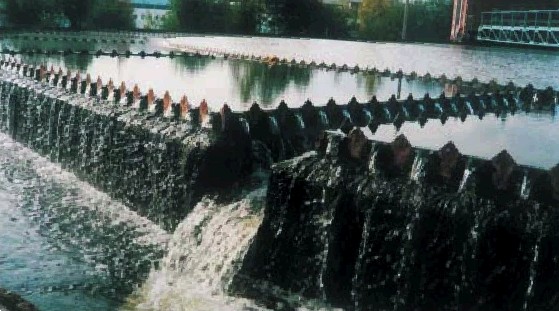
Waste water treatment plant in St. Petersburg
Travel the waterways of St. Petersburg
St. Petersburg was founded by Peter the Great in 1703. Our poet A. S. Pushkin called St. Petersburg “The Water Element” as there are more than 40 rivers and channels in the city. Often it is referred to as the Palmyra of the North or the Venice of the north, a poetic metaphor that is quite justified.
All the rivers feed into the main river, the Neva, which forms a delta in St. Petersburg and runs into the Gulf of Finland. The Neva, therefore, has significant anthropogenic influence -from the huge Lake Ladoga, and from all other rivers flowing into it, such as the Ochta, the Okkervil and the Zhernovka. Waste substances from industries and household drains that are released into streams and rivers will enter the Neva, and the navigation and number of ships on the river also has an impact.
Monitoring the quality of the water of the River Neva shows an increase of organic substances and hazardous substances, such as phenols, manganese, copper and lead.
Water flows into the Neva from many other rivers, one of them the Ochta. Numerous factories are situated along the banks of the Ochta, among them the three largest chemical manufacturers of the north-west region: the chemical fibre factory, the medical polymer factory, and the layered plastic factory. In addition, there are shipbuilding industries, metal working enterprises, and two huge productions, the Institute of Rubber and the Institute of Applied Chemistry, as well as many others.
Monitoring the river upstream from a green zone with beaches, boat stations and no industries, we find that the banks are clean, without dumps and dust, with trees and bushes, creating favourable conditions for people’s relaxation.
Following the river downstream, numerous rains cause the sandy bottom to become muddy, the water to have an unpleasant smell and be covered in petrol spots, and benthos plants to disappear. When we reach the entrance to the Neva, we find empty shells of molluscs, as well as molluscs with an abnormal shape! Chemical analyses show the presence of very little oxygen and an excess of iron, copper, manganese, phenols, nitrates and petroleum.
To check the results, we grew cress–salads, which showed a clear decrease in sprouting seeds, proving the presence of pollutants in the investigated samples.
In other rivers it seems that conditions have worsened when we use our bioindicators for estimating the water quality. The reproduction rate of algae has lowered, and the effect on Daphnia is lethal!
After travelling the microbes, the air and the waterways of St. Petersburg, it is now time to present our report: Some of the consequences may influence people’s health. Using the bioindicators and chemical analyses, the students are able to observe the changes and to use the results to foresee the outcome of the changes. They are able to use their knowledge in different situations, they are able to develop collaboration skills in solving problems, and they are able to understand that the local activity influences others sometimes even far away.
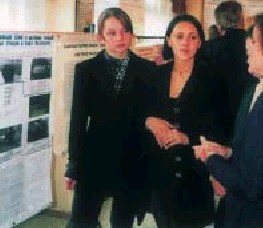
The students inform others of their work – here in the school assembly hall
The students inform others of their work through participating in ecological olympiads and in seminars on ecological conditions.
Education for sustainable development is necessary to meet the challenges of the 21st century!
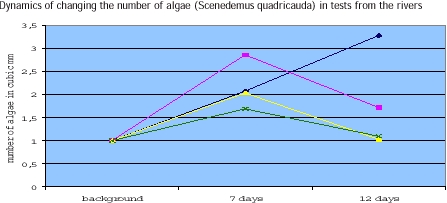
Algae are influenced by industrial and household waste in St. Petersburg rivers
Tourism – Pelle and Lisa in the Stockholm Archipelago
By Malin Davelius, Sofie Renemar, Veronica Gustavsson and Sanna Elstad, Sweden
Pelle and Lisa have planned a boat trip in the Stockholm archipelago for the summer. Now the time has finally come to depart. They go to the Waxholm boat in Stockholm. It is crowded with happy and expectant tourists. Lisa and Pelle stand in the rear gazing at all the islands that the boat passes. All of a sudden they catch sight of the smoke that quells out of the funnel on the boat.
“That smoke can certainly not be doing nature any good,” says Pelle.
An elderly woman comments that she has been working for 20 years as a technician in the Waxholm company. She informs Pelle and Lisa that the boats consume five million litres of diesel fuel every year.
“Oh, that is a lot,” says Lisa, “How many boats are there?” “We have 20 boats and they sail a total of 35,000 hours every year. Mind you, the exhaust is nothing compared to what cars emit into the surrounding atmosphere.” “I see. We learnt at school why cod are having difficulties surviving in the Baltic Sea. We learnt that the NOx that cars emit increases the eutrophication of the Baltic Sea as well as acid rain, and that problems thus occur in nature, even in the archipelago.” “Well, that is true, but there are other problems. You see, when the boats move off, a lot of bottom sediment is suspended into the water column; the sediment contains poisons and heavy metals that harm life in the archipelago more than the emissions. The stern waves also have a negative impact on nature and the noise from the boats disturbs bird life in the area. “Well, I did not know that,” says Pelle.
As a result, we chose boat tourism in the Stockholm archipelago as our topic, and we investigated islands that represent the Stockholm archipelago, i.e. that differ in size and number of visitors, etc.
We had help from the Archipelago Establishment, the Environmental Protection Agency, and Värmdö Municipality in finding answers to the following questions:
- Do tourists know of the “Every Man’s Right” in Sweden?
- Are the rules followed?
- How are tourist informed?
- Is waste sorted? At source?
- Is waste removed from beaches and camping sites? If so, how often?
- How does tourism affect animal life?
On the islands investigated we had help from hotels, restaurants, camping sites, youth hostels, etc. to answer the following questions:
- How many people visit the island every summer?
- What percentage of visitors are Swedish and of foreign nationality?
- Is waste sorted?
- How are the houses heated?
- What kind of sewage system is used - a loo or water closet?
- Is waste water treated?
The Waxholm boats link the islands, and are used not only for tourism but also for everyday necessities and delivery of goods, as well as for bringing waste ashore. We asked the company the following questions:
- In what way do the Waxholm boats affect animals and nature?
- What kind of fuel do the boats need for their energy supply?
Finally we asked various grocery stores the following questions:
- Do you compost your wet waste?
- What happens to the other waste products?
- Do you have a grill bar? If so, what do you do with the oil?
- How is waste taken away?
We can make the following conclusive comments:
Islands with a minor tourist impact know the most about environmental issues.
- Island residents protect nature by sorting waste and by composting.
- Grocery stores are small, and therefore sorting waste, etc is manageable.
- Restaurants: The bigger, the less sorting! Big restaurants have no sorting procedure, small restaurants sort waste into plastic, paper and compost.
- Youth hostels, camping cabins and summer cottages have signs with waste-sorting information.
- Youth hostels have loos that are composted.
- Electricity or wood are energy sources for heating houses, but as visitors mainly come in the summer, this is no great issue.
- According to the Archipelago Establishment, animal life is not very affected by visitors. The animals know where people move around, and there are protected islands with restricted admittance. There are special clean-up actions, especially after big holidays, as broken glass and even plastic rings pose a threat to animals.
- Tourists seem to have learnt how to acquire knowledge on how to behave, and most visitors know of the “Every Man’s Right”, so unique to Sweden. The Stockholm archipelago is unique, too.
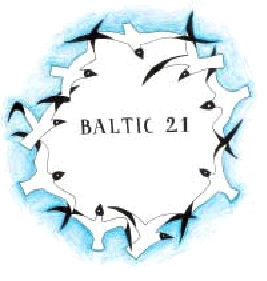
Helen Litvinova, Russia
Tourism and Energy
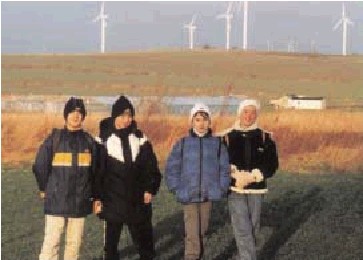
The first Polish wind turbines were built in Cisowo in 1999
By Teresa Kaminska, Poland
Our school, Junior Secondary School No. 1, in Ustka has developed its own curriculum for the subject »ecology and tourism« for some years now. Our curriculum is based on activities conducted in the open area. We combine ecological education with our interest for walking tourism.
We have been interested in the topic of alternative energy since the first wind power station was built in our region. To find out more about it, we met with the architect of the first wind farm in Poland. We also participated in an ecological seminar in Duninowo devoted to the topic of renewable energy in our area. We also learned about some activities of solar and geothermal power stations by meeting their owners. We informed them, as well as the local newspaper, about our activities at school within the field of ecology and tourism.
Ustka is situated on the coast, in the region that has the best parameters concerning wind. It is an excellent location for wind power stations, and the winds blow as much as in Denmark and northern Germany. According to the wind zones into which our country has been divided, it is only our region and the northeast part of Suwalszczyzna that have such advantageous conditions.
Among the countries wanting to join the EU, Poland is the first one to formulate »A Strategy of Development of Renewable Energy«. Our country has also met all the obligations imposed by the EU. It is now the task of our Ministry of Environment to implement this strategy.
In accordance with the instructions of the EU, 8% of electric power produced in Poland by 2005 has to be »white energy«, i.e. coming from renewable sources such as wind or water power stations. By 2010, the figure should be 12%.
Yesterday
In the past, people in this region obtained energy only by burning pit-coal. With time, a few small water power stations have also been built.
The first information we have about wind turbines comes from the 18th century. They were single wind power stations used for driving wind turbines to grind grain in order to obtain flour.
In the 1980’s near Darlowo, at Kopan Lake and in Zarnowiec, plans were made to build a nuclear power station. Construction began in Zarnowiec and work rapidly progressed. In Dar-lowo, this led to the creation of the first Citizen Committee in Poland, also known as “The Watch”, which organised a huge protest against the establishment of the nuclear power station. The protest was a success and construction work was halted. Since that time ecological seminars have been organised every two years in Darlowo. Where the nuclear power station was intended to have been built, wind turbines are now being constructed!
The decision about the location was preceded by two years of research on wind strength in the entire region. Positive results confirmed the profitability of wind power stations and enabled the National Environment Protection Fund to allocate favourable credits. This attracted investors, who purchased the land in the area for the purpose of building power stations there.
It took quite some time to convince the local authorities of the benefits of investment. Their decision was partly influenced by the possibility to employ local people in the construction of the plant as well as in the work connected with laying electricity cables in the ground. These would be additional workplaces.
Finally, in April 1999, in Cisowo, a small place about 35 km from Ustka, the first wind farm in Poland was built. It consisted of five wind power stations.
Today
At present, most Polish wind power stations are located in our region. It is still the biggest cluster of wind power stations in Poland. In Cisowo, four more mills have now been erected, while a few kilometres away, another farm consisting of seven power stations has been built.
Unfortunately, wind power stations in Poland still have very limited application. This is due partly to the extremely high cost of building them and partly to the defective regulations currently in force in Poland. These are the main reasons why the power stations are on the verge of bankruptcy, as electricity companies do not buy electricity from the mills. Therefore, foreign companies ready to invest in power stations in Poland are hesitant to carry through with their plans.
Tomorrow
If new regulations do not deter foreign companies, then over 100 wind power stations with 2,000 turbines will be built in our municipality along the entire Polish coast. They will be farms composed of a few wind turbines, situated 500-600 m away from residential areas.
These farms will take into account bird routes and will also be a safe distance from National Parks.
Tourist route
Over the years a change in the local people’s attitude towards the power stations has been observed. Initially, they were hostile to them, claiming that they would disturb and alter the landscape, make considerable noise, and scare away holiday-makers.
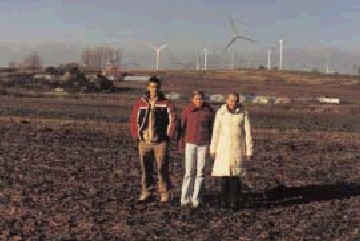
Will there be more than 100 mills here in the future? Wind turbines in Cisowo 2002
With new technology, the noise created by the wings of the mills has become less troublesome. It has also turned out that the stations do not scare tourists away; on the contrary, they attract them. There is even a tourist route called the »Wind power stations’ route« in the area.
However, as long as our regulations discourage the purchase of energy from alternative power stations, it is difficult to talk about profitability.
In connection with the date when our country will join the EU, there is hope that the issue will soon be resolved.
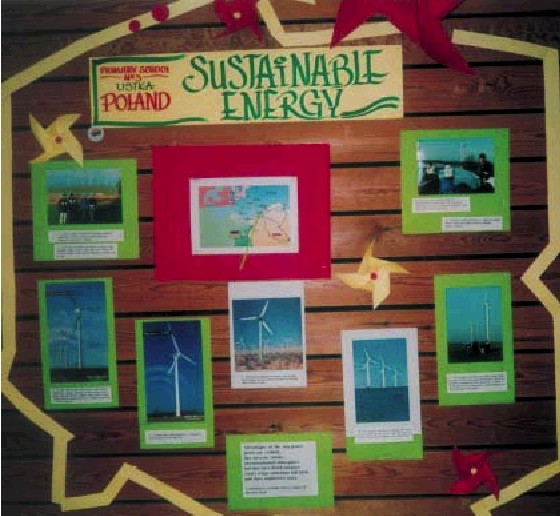
Ustka students present their research on wind turbines at the »On the Threshold -Baltic 21« conference in Sønderborg, June 2000
Transport: Exhaust Fumes – Research on Traffic Pollution
By Anda Deksne, Latvia
In our school every secondary-level student is required to choose and complete a research paper during the three years of their studies. Students are free to choose the theme of the paper, with many choosing environmental–related themes.
The research paper in question had been completed as an extracurricular project in the students’ free time. The research was carried out during one academic year by two secondary school students, Liga Birsa and Valdis Celmins.
Before embarking on the research work, the students gathered basic information (in biology and chemistry lessons) on air contents and air pollutants, as well as the problems of air quality.
Of course, more information was needed, and thus the students did a detailed study of reference literature on air quality, as well as on the contents of exhaust fumes and their harmful influence on the environment and all living organisms.
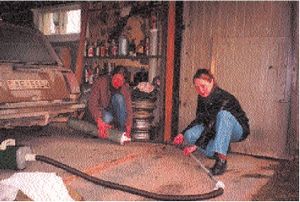
Students measuring exhaust fumes
The objective was to perform experiments aimed at measuring the contents of harmful substances in the exhaust fumes of cars of various ages and countries of manufacture.
In the experimental part of the paper, the students measured the concentration of carbon monoxide (CO) and non–reduced hydrocarbons in exhaust fumes. To complete this task, they went to the technical inspection centre of the Road and Traffic Safety Department.
The investigation showed that the contents of the exhaust fumes is not dependent on the car‘s age, but on the petrol feeder‘s adjustment. About 4-9% of cars fail the test, which applies to cars of various ages (years of manufacture 1980 – 1990).
The students also attempted to measure the amount of hard particles in exhaust fumes. For this purpose they constructed a special ’device’ – consisting of a vacuum cleaner, a paper filter, a Bihner funnel and a pipe connected to the car‘s exhaust pipe.
The chosen cars were run for five minutes at a low revolution rate (idle run). With the help of the vacuum cleaner, the fumes were pumped through the filter, where the hard particles were absorbed. After filtration, each filter was weighed. The result showed that every car in five minutes emits 50–700 mg of hard particles. The amount of hard particles depends on the car‘s age and make, and whether the has a catalytic converter or not.
The research group students involved several junior pupils in their investigation work. They helped in counting cars, for the purpose of estimating the traffic load at the major junctions of the local town Rujiena. They counted the cars from 7 am to 7 pm. The calculation shows that the number of vehicles passing a junction reaches 1,500 – 2,300 in 12 hours.
One part of the project was a public poll on air pollution. 78% of the pollees were concerned about the air pollution and considered it as a serious problem in the rural areas. The major polluters in Rujiena were considered to be traffic and the local boiler houses.
The students took more delight in the practical part of the research than in the literature study and the result analysis. However, it was a rewarding job, because the project group could present their work to their school peers, as well as take part in a nationwide competition.
The problem was that not all owners were responsive and willing to take part in the exhaust fume test with their vehicle, because it was necessary to have free access to the electricity source in order to operate the vacuum cleaner.
From Words to Action
“So Was” helps us sort the waste
By Urmas Tokko, Estonia
Tartu Tamme Gümnasium is the biggest school in terms of pupils and staff in the city of Tartu –with about 1,300 pupils from grades 1-12 and 100 members of staff. Altogether, we have more than 50 rooms in the school building.
Naturally, different kinds of paper products make up the main waste in a school. Therefore, sorting waste into at least two groups is extremely real and natural in Estonia at the moment. “This may be a good and simple beginning, but it is not enough,” we thought when we started the project. School is the most suitable place for this kind of beginning: pupils, as future citizens of the world, should be taught about the importance of the environment from an early stage. The environmental awareness of pupils will influence families and eventually other enterprises, such as the parents’ workplaces.
The slogans “From Words to Action” and “Think Globally, Act Locally” should have a real meaning!
Students from Form 11B, a special natural sciences class, were the main participants in this project. Financial support was applied for from the SAS & Coca-Cola Environmental Foundation and also through a project competition on sustainable development called “Keep the city clean”, organised by Tartu Municipality.
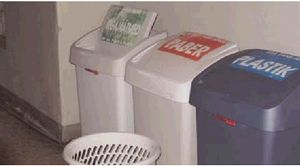
Sort your waste, please: Mixed waste (green label), Papers only (red label) and Plastics only (blue label)
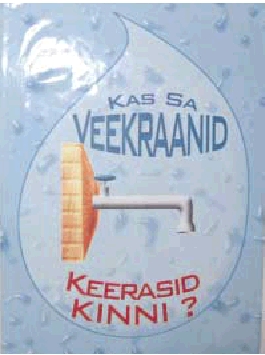
“Did you remember to turn off the tap?”
Our local decision-makers found our idea worthwhile implementing and they gave us a project budget of approximately 1700 Euros. Not much, but a start.
With this money we now have three different bins in every classroom and public room in the large school building. Each bin is labelled with a clear message in a coloured label that the students designed using a special computer program.
We also learnt about how to sort garbage, and we also made an attractive information stand for our fellow pupils.
The sticky labels were ordered via the Inter-net from Tallinn, and were sent to us through the post: Modern society! In addition to the labels for rubbish bins, we have now placed information labels around the school to raise people’s awareness: “Did you leave the lights on?” and “Consume rationally!” to mention two.
Thus, investment into environmentally-friendly management of waste and rubbish was combined with education for sustainability of pupils and grown-ups connected to the school.
We had a rather funny problem getting the right boxes. As we needed more than 160 boxes in different colours, no store had these all in stock. So we ordered the boxes from the Netherlands through an Estonian firm, but at first we got boxes that were twice the size! We eventually got the right-sized boxes, but the colour was not what we had been expecting. The students pointed out that the colours should be in harmony with the colours painted on the walls, and that as red might attract more attention, it should be used for the most frequent type of waste.
As a preliminary result of the project, we can mention both positive and negative things. In terms of feedback from room cleaners, we are glad they that they have not complained about the additional work for them (More rubbish bins!). Our teachers and pupils are generally satisfied and pleased about the “new” situation, and teachers are happy to educate pupils on how to sort waste in their regular lessons.
We have as yet not noticed any intentional incorrect sorting of waste.
Nevertheless:
- Quite a lot of mixing still takes place. We think this is due to both carelessness and the normal hustle and bustle of school life. Therefore, more effort should be made to educate pupils.
- The big outdoor containers next to the school building are being used also by local people. They just throw their waste into the school’s containers no matter where they happen to be.
- Our plastic boxes are perhaps not solid enough for the number of youngsters using them.
Still, we think we have made a good start in our efforts to promote a more sustainable development! We also think our efforts are the first of their kind in Estonian schools.
Why “So Was”?
The title can be understood in at least two different ways.
First, it can be “So it was” – with the sentence marking people’s indifferent attitude to environmental problems in the past. The sentence also embraces the widely-held view of individuals that “I personally can’t do anything in that field”. This way the title of the project is an optimistic glance into the future, where we pay more attention to environmental problems and our attitude towards them.
Second, the words “So” and “Was” mark the beginning of the English words ’SOrting’ and ’WASte’.
The title thus gives a direct indication of the content of the project.
In addition, “So Was” has a meaning in German, where “NA SO WAS!” would typically be said to express surprise. SO WAS is something extraordinary, adorable, amazing or unbelievable.
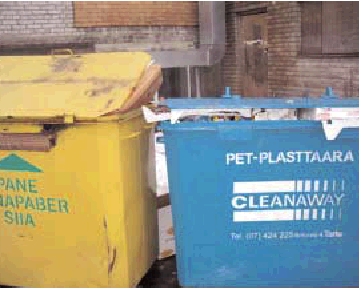
Paper and plastic for recycling in their separate containers
The title thus asks a question which addresses a number of dilemmas under discussion nowadays. For example, does sorting waste into different dustbins cause less damage than by NOT sorting waste? We believe so. Mixed garbage is taken to the local dump. But if sorted, paper is taken to a paper factory in Tallinn, and plastic to a firm in Tallinn, where foreign companies buy it as a resource material for producing another form of plastic!

Denne side indgår i publikationen "EDUCATION FOR SUSTAINABLE DEVELOPMENT" som kapitel 5 af 8
© Undervisningsministeriet 2003
|